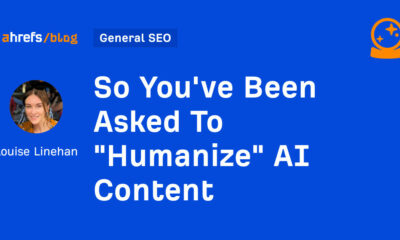MARKETING
Tech Marketers Shine But Face a Big Hurdle: Content Operations [New Research]
![Tech Marketers Shine But Face a Big Hurdle: Content Operations [New Research] Tech Marketers Shine But Face a Big Hurdle: Content Operations [New Research]](https://articles.entireweb.com/wp-content/uploads/2022/03/1648030314_Tech-Marketers-Shine-But-Face-a-Big-Hurdle-Content-Operations.png)
Content marketers at technology companies have a good handle on content marketing, according to our latest research. They’ve got a strategy, and they know if it’s working because they measure and report results. And most expect more budget to work with this year.
Does that mean tech company marketers avoid the challenges and growing pains that keep their colleagues in other industries up at night?
Not quite.
To find out the challenges tech companies face (as well as they’re planning to invest), let’s examine the findings in CMI’s Technology Content Marketing Benchmarks, Budgets, and Trends with Insights for 2022 sponsored by Foundry. The report reflects responses from 216 content marketers at for-profit technology companies who participated in the 12th annual Content Marketing Institute/MarketingProfs survey in July 2021.
Where tech content marketers excel
First, let’s explore some areas where tech marketers report success.
Most technology marketers approach content marketing strategically. According to our latest round of content marketing research, nearly all (95%) have a strategy or plan to develop one within the next 12 months.
Eighty-three percent of those surveyed rated their overall content marketing approach as extremely, very, or moderately successful in the last 12 months.
83% of #tech marketers rate their #ContentMarketing as extremely, very, or moderately successful, according to @CMIContent #research via @LisaBeets. Click To Tweet
And they have a pretty good picture of how they’re doing because more than three quarters (79%) measure content performance. Of those who measure, 36% rate their ability to show ROI as excellent or very good. For this survey, excellent means they have measurement data showing ROI on their overall content marketing. Very good indicates they have data to show ROI for at least one content marketing initiative and insights into other areas.
Another big chunk (52%) rate their measurement ability as average, which means they have well-informed insights but lack measurement data showing ROI.
Half of tech marketers rate their ability to measure as average. They have informed insights but lack ROI measurement, according to @CMIContent #research via @LisaBeets. Click To Tweet
![Tech Marketers Shine But Face a Big Hurdle: Content Operations [New Research] How technology marketers characterize their team's ability to demonstrate content marketing roi.](https://articles.entireweb.com/wp-content/uploads/2022/03/1648030314_842_Tech-Marketers-Shine-But-Face-a-Big-Hurdle-Content-Operations.jpg)
The ability to measure and report on ROI might explain why they’re maintaining and even increasing their budgets. Nearly half (49%) reported their 2021 content marketing budget increased over their 2020 budget.
Budgets looked even better for this year: 68% expected their 2022 content marketing budget to be bigger than the 2021 budget.
![Tech Marketers Shine But Face a Big Hurdle: Content Operations [New Research] How technology content marketing budget will change in 2022 compared with 2021.](https://articles.entireweb.com/wp-content/uploads/2022/03/1648030314_382_Tech-Marketers-Shine-But-Face-a-Big-Hurdle-Content-Operations.jpg)
Where tech marketers plan to invest in 2022
What do they plan to do with that 2022 budget? Many plan to spend on events. When asked how the rollout of the COVID-19 vaccine would change their investments, most said they would stay the course or increase spending on digital events (50% planned to spend the same amount on digital/virtual events, and 25% planned to spend more).
But 61% said they planned to increase in-person event spending on in-person events. That’s a significant number, but keep in mind only 17% said they’d used in-person events for content marketing in the past 12 months.
![Tech Marketers Shine But Face a Big Hurdle: Content Operations [New Research] How technology organizations' investment will change in following areas post-vaccine.](https://articles.entireweb.com/wp-content/uploads/2022/03/Tech-Marketers-Shine-But-Face-a-Big-Hurdle-Content-Operations.png)
What’s left?
Marketers at tech companies think their programs are decently successful. They can show it with numbers, and (perhaps therefore) they’re maintaining or increasing budgets.
What’s left to worry about?
In combing through the data, the biggest challenges for technology content marketers primarily involve internal stumbling blocks. Tech content marketers indicate they’re challenged in:
![Tech Marketers Shine But Face a Big Hurdle: Content Operations [New Research] Technology organizations' current content marketing challenges bar chart.](https://articles.entireweb.com/wp-content/uploads/2022/03/1648030314_558_Tech-Marketers-Shine-But-Face-a-Big-Hurdle-Content-Operations.jpg)
Over half of tech marketers say they are challenged to create #content that appeals to multi-level roles within the target audience, according to @CMIContent #research via @LisaBeets. Click To Tweet
Those findings indicate a need for a content operations framework. Content operations, as Ann Gynn writes, is “the machine that turns a content marketing strategy into the product of content marketing.”
A content operations framework documents the people, process, and technology involved in producing content for the organization. Creating this framework helps organizations ensure the correct staff (internal or outsourced) are in place to produce content, that they have the guidelines they need (think personas, style guides, etc.), and that everyone involved knows the mission behind the content.
“A formal, documented, enforced content operation framework powers and empowers a brand’s ability to deliver the best possible customer experiences throughout the audiences’ journeys,” Cathy McKnight explains.
A documented, enforced #ContentOperations framework powers a brand’s ability to deliver the best possible experiences, says @CathyMcKnight via @LisaBeets @CMIContent. Click To Tweet
Technology sales cycles can be long and involve many people at differing levels of technical expertise and different content needs. A formal approach to content operations may be the thing to push more tech marketers from moderately successful into the top-performer tier.
See Technology Content Marketing Benchmarks, Budgets, and Trends with Insights for 2022 to explore the complete findings, including:
- What top-performing tech marketers do differently from the rest
- How team structure and outsourcing approaches differ at small and large tech companies
- Which paid and organic channels tech marketers use (and which perform best)
- Action steps for the rest of 2022
Cover image by Joseph Kalinowski/Content Marketing Institute
MARKETING
YouTube Ad Specs, Sizes, and Examples [2024 Update]
![YouTube Ad Specs, Sizes, and Examples [2024 Update] YouTube Ad Specs, Sizes, and Examples](https://articles.entireweb.com/wp-content/uploads/2024/06/YouTube-Ad-Specs-Sizes-and-Examples.jpg)
Introduction
With billions of users each month, YouTube is the world’s second largest search engine and top website for video content. This makes it a great place for advertising. To succeed, advertisers need to follow the correct YouTube ad specifications. These rules help your ad reach more viewers, increasing the chance of gaining new customers and boosting brand awareness.
Types of YouTube Ads
Video Ads
- Description: These play before, during, or after a YouTube video on computers or mobile devices.
- Types:
- In-stream ads: Can be skippable or non-skippable.
- Bumper ads: Non-skippable, short ads that play before, during, or after a video.
Display Ads
- Description: These appear in different spots on YouTube and usually use text or static images.
- Note: YouTube does not support display image ads directly on its app, but these can be targeted to YouTube.com through Google Display Network (GDN).
Companion Banners
- Description: Appears to the right of the YouTube player on desktop.
- Requirement: Must be purchased alongside In-stream ads, Bumper ads, or In-feed ads.
In-feed Ads
- Description: Resemble videos with images, headlines, and text. They link to a public or unlisted YouTube video.
Outstream Ads
- Description: Mobile-only video ads that play outside of YouTube, on websites and apps within the Google video partner network.
Masthead Ads
- Description: Premium, high-visibility banner ads displayed at the top of the YouTube homepage for both desktop and mobile users.
YouTube Ad Specs by Type
Skippable In-stream Video Ads
- Placement: Before, during, or after a YouTube video.
- Resolution:
- Horizontal: 1920 x 1080px
- Vertical: 1080 x 1920px
- Square: 1080 x 1080px
- Aspect Ratio:
- Horizontal: 16:9
- Vertical: 9:16
- Square: 1:1
- Length:
- Awareness: 15-20 seconds
- Consideration: 2-3 minutes
- Action: 15-20 seconds
Non-skippable In-stream Video Ads
- Description: Must be watched completely before the main video.
- Length: 15 seconds (or 20 seconds in certain markets).
- Resolution:
- Horizontal: 1920 x 1080px
- Vertical: 1080 x 1920px
- Square: 1080 x 1080px
- Aspect Ratio:
- Horizontal: 16:9
- Vertical: 9:16
- Square: 1:1
Bumper Ads
- Length: Maximum 6 seconds.
- File Format: MP4, Quicktime, AVI, ASF, Windows Media, or MPEG.
- Resolution:
- Horizontal: 640 x 360px
- Vertical: 480 x 360px
In-feed Ads
- Description: Show alongside YouTube content, like search results or the Home feed.
- Resolution:
- Horizontal: 1920 x 1080px
- Vertical: 1080 x 1920px
- Square: 1080 x 1080px
- Aspect Ratio:
- Horizontal: 16:9
- Square: 1:1
- Length:
- Awareness: 15-20 seconds
- Consideration: 2-3 minutes
- Headline/Description:
- Headline: Up to 2 lines, 40 characters per line
- Description: Up to 2 lines, 35 characters per line
Display Ads
- Description: Static images or animated media that appear on YouTube next to video suggestions, in search results, or on the homepage.
- Image Size: 300×60 pixels.
- File Type: GIF, JPG, PNG.
- File Size: Max 150KB.
- Max Animation Length: 30 seconds.
Outstream Ads
- Description: Mobile-only video ads that appear on websites and apps within the Google video partner network, not on YouTube itself.
- Logo Specs:
- Square: 1:1 (200 x 200px).
- File Type: JPG, GIF, PNG.
- Max Size: 200KB.
Masthead Ads
- Description: High-visibility ads at the top of the YouTube homepage.
- Resolution: 1920 x 1080 or higher.
- File Type: JPG or PNG (without transparency).
Conclusion
YouTube offers a variety of ad formats to reach audiences effectively in 2024. Whether you want to build brand awareness, drive conversions, or target specific demographics, YouTube provides a dynamic platform for your advertising needs. Always follow Google’s advertising policies and the technical ad specs to ensure your ads perform their best. Ready to start using YouTube ads? Contact us today to get started!
MARKETING
Why We Are Always ‘Clicking to Buy’, According to Psychologists

Amazon pillows.
MARKETING
A deeper dive into data, personalization and Copilots

Salesforce launched a collection of new, generative AI-related products at Connections in Chicago this week. They included new Einstein Copilots for marketers and merchants and Einstein Personalization.
To better understand, not only the potential impact of the new products, but the evolving Salesforce architecture, we sat down with Bobby Jania, CMO, Marketing Cloud.
Dig deeper: Salesforce piles on the Einstein Copilots
Salesforce’s evolving architecture
It’s hard to deny that Salesforce likes coming up with new names for platforms and products (what happened to Customer 360?) and this can sometimes make the observer wonder if something is brand new, or old but with a brand new name. In particular, what exactly is Einstein 1 and how is it related to Salesforce Data Cloud?
“Data Cloud is built on the Einstein 1 platform,” Jania explained. “The Einstein 1 platform is our entire Salesforce platform and that includes products like Sales Cloud, Service Cloud — that it includes the original idea of Salesforce not just being in the cloud, but being multi-tenancy.”
Data Cloud — not an acquisition, of course — was built natively on that platform. It was the first product built on Hyperforce, Salesforce’s new cloud infrastructure architecture. “Since Data Cloud was on what we now call the Einstein 1 platform from Day One, it has always natively connected to, and been able to read anything in Sales Cloud, Service Cloud [and so on]. On top of that, we can now bring in, not only structured but unstructured data.”
That’s a significant progression from the position, several years ago, when Salesforce had stitched together a platform around various acquisitions (ExactTarget, for example) that didn’t necessarily talk to each other.
“At times, what we would do is have a kind of behind-the-scenes flow where data from one product could be moved into another product,” said Jania, “but in many of those cases the data would then be in both, whereas now the data is in Data Cloud. Tableau will run natively off Data Cloud; Commerce Cloud, Service Cloud, Marketing Cloud — they’re all going to the same operational customer profile.” They’re not copying the data from Data Cloud, Jania confirmed.
Another thing to know is tit’s possible for Salesforce customers to import their own datasets into Data Cloud. “We wanted to create a federated data model,” said Jania. “If you’re using Snowflake, for example, we more or less virtually sit on your data lake. The value we add is that we will look at all your data and help you form these operational customer profiles.”
Let’s learn more about Einstein Copilot
“Copilot means that I have an assistant with me in the tool where I need to be working that contextually knows what I am trying to do and helps me at every step of the process,” Jania said.
For marketers, this might begin with a campaign brief developed with Copilot’s assistance, the identification of an audience based on the brief, and then the development of email or other content. “What’s really cool is the idea of Einstein Studio where our customers will create actions [for Copilot] that we hadn’t even thought about.”
Here’s a key insight (back to nomenclature). We reported on Copilot for markets, Copilot for merchants, Copilot for shoppers. It turns out, however, that there is just one Copilot, Einstein Copilot, and these are use cases. “There’s just one Copilot, we just add these for a little clarity; we’re going to talk about marketing use cases, about shoppers’ use cases. These are actions for the marketing use cases we built out of the box; you can build your own.”
It’s surely going to take a little time for marketers to learn to work easily with Copilot. “There’s always time for adoption,” Jania agreed. “What is directly connected with this is, this is my ninth Connections and this one has the most hands-on training that I’ve seen since 2014 — and a lot of that is getting people using Data Cloud, using these tools rather than just being given a demo.”
What’s new about Einstein Personalization
Salesforce Einstein has been around since 2016 and many of the use cases seem to have involved personalization in various forms. What’s new?
“Einstein Personalization is a real-time decision engine and it’s going to choose next-best-action, next-best-offer. What is new is that it’s a service now that runs natively on top of Data Cloud.” A lot of real-time decision engines need their own set of data that might actually be a subset of data. “Einstein Personalization is going to look holistically at a customer and recommend a next-best-action that could be natively surfaced in Service Cloud, Sales Cloud or Marketing Cloud.”
Finally, trust
One feature of the presentations at Connections was the reassurance that, although public LLMs like ChatGPT could be selected for application to customer data, none of that data would be retained by the LLMs. Is this just a matter of written agreements? No, not just that, said Jania.
“In the Einstein Trust Layer, all of the data, when it connects to an LLM, runs through our gateway. If there was a prompt that had personally identifiable information — a credit card number, an email address — at a mimum, all that is stripped out. The LLMs do not store the output; we store the output for auditing back in Salesforce. Any output that comes back through our gateway is logged in our system; it runs through a toxicity model; and only at the end do we put PII data back into the answer. There are real pieces beyond a handshake that this data is safe.”
-

 SEO7 days ago
SEO7 days agoGoogle’s Revamped Documentation Shows 4 Reasons To Refresh Content
-
SEARCHENGINES5 days ago
Daily Search Forum Recap: August 26, 2024
-

 SEARCHENGINES7 days ago
SEARCHENGINES7 days agoGoogle Ranking Bug Fixed, August Core Update Swings, AI Overviews, Google Ads Bug & More
-

 WORDPRESS7 days ago
WORDPRESS7 days agoHow to Secure Your WordPress Store
-
SEARCHENGINES4 days ago
Daily Search Forum Recap: August 27, 2024
-

 AFFILIATE MARKETING7 days ago
AFFILIATE MARKETING7 days agoBusiness Owners are Batting 1,000 With This All-in-One Management Hub
-

 SEARCHENGINES6 days ago
SEARCHENGINES6 days agoGoogle Migrating All To Google Merchant Center Next By September
-

 WORDPRESS5 days ago
WORDPRESS5 days ago10 Best StudioPress Alternatives (Genesis Framework)













You must be logged in to post a comment Login